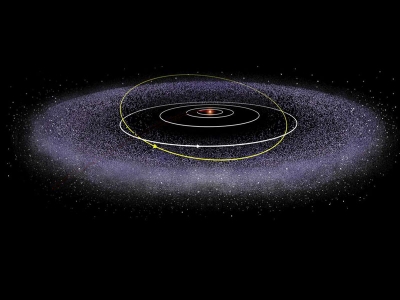
The Kuiper Belt is a ring of icy bodies found outside Neptune’s orbit. This is also where you will find Pluto, the dwarf planet, and the belt’s most famous object.
Why Kuiper?
The Kuiper Belt is named after scientist Gerard Kuiper who, in 1951, had an idea that a belt of icy bodies might have existed beyond Neptune when the solar system formed. Kuiper was trying to explain where comets with small orbits came from, and no one had seen any beyond Neptune yet. Even with the best of telescopes, it was hard to spot small comets past Neptune. But Kuiper made a prediction of comets and icy bodies past Neptune and his prediction turned out right! In 1992, the first of three strange bodies, which astronomers call Kuiper Belt Objects, was discovered by astronomers Dave Jewitt and Jane Luu using the University of Hawaii’s 2.2-m telescope.
Meet the residents
The Kuiper Belt is home to bits of ice and rock, comets, and dwarf planets. Apart from Pluto, some of the popular residents of the Kuiper belt are Eris, Haumea, and Arrokoth.
Eris
A dwarf planet slightly smaller than Pluto, Eris is so far off in the solar system that it takes 557 years to orbit the Sun. Like Pluto, Eris has a small moon named Dysnomia Eris was discovered on October 21, 2003.
Haumea
Haumea is a dwarf planet like Pluto about 10 times smaller than Earth. It is one of the fastest rotating large objects in our solar system. Though it takes 285 years to orbit the Sun, a day in Haumea is only four hours! The dwarf planet has two moons called Namaka and Hi’iaka. Haumea was discovered in 2003,
Arrokoth
This is a small object in the Kuiper Belt that looks like a flattened snowman. Arrokoth is the most distant and most primitive object ever explored by a spacecraft It was discovered on June 26, 2014, by New Horizons science team member Marc Buie using NASA’s Hubble Space Telescope.
Picture Credit : Google
